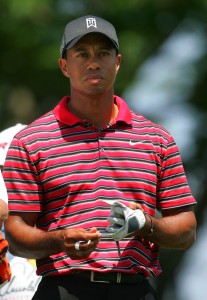
Tiger Woods should play in the Fall Series, and now even Presidents Cup captain Fred Couples says so. Photo copyright Icon SMI.
It’s been a strange year for Tiger Woods. Not quite as strange as 2009 or 2010, but not the back to normal year we expected.
By “normal,” I don’t mean that we expected Woods to dominate the game the way he used to. But it was a year when we figured to find out what his new normal was. The verdict would be in on the swing changes undertaken with Sean Foley and on whether he would be able to regain the mental edge he seemed to lose in a scandal- and divorce-plagued year of 2010.
Instead, we’ve seen Woods play so little—and not particularly distinguish himself when he did—that he hasn’t even qualified for the FedExCup. So now he’s on the sidelines yet again, at a time when he needs to be playing. Instead of more answers, we’ve only gotten more questions.
One of those questions: Will he play in the Fall Series? He should. Now even Presidents Cup captain Fred Couples is saying so. Couples (foolishly, I think) earlier had said that Woods was a lock for a Presidents Cup pick if he wanted to play in it. But Woods missing the FedExCup means that since April he has only a WD at the Players, a mediocre performance at Firestone, and a missed cut at the PGA Championship.
That’s not enough. And Woods is blocked not only from the FedExCup, he also won’t qualify for the WGC-HSBC Champions in November, which is limited to tournament winners and top players from the world ranking. He’s playing in the Australian Open in November the week before the Presidents Cup, but that would be a gap of three months since his last appearance.
There are two steps for Woods to try to resurrect his game. The first is practice. He needs to hit plenty of balls to knock the rust off—and also to continue to work on the “new” swing.* We don’t know if Woods’ knee and Achilles will allow him to go dawn-to-dusk every day, but surely with all this free time in the coming weeks he can at least hit the range often enough to do some serious work.
*Actually the swing is more than a year old, but Woods hasn’t played enough for it to be fully ingrained.
The second step is tournament competition. He needs that to knock the tournament rust off, because playing in competition is different than hitting balls on the range. If he waits until November to return, he will be back to square one. He’s got a couple of alternatives: the Fall Series and the European Tour.
Woods made his debut on Tour back in the fall of 1996. That was when he was starting out. It would be appropriate for him to go back to playing in the fall now that he’s starting over.
Woods’ first PGA Tour victory came in Las Vegas. Well, OK, maybe playing in Vegas wouldn’t be the best move right now. That leaves three Fall Series events: the Frys.com Open at CordeValle in California, the McGladrey Classic at Sea Island, Georgia; and the Disney event in Orlando. The McGladrey is hosted by 2012 U.S. Ryder Cup captain Davis Love III, so that would be a good one. Disney is no longer a home game, since Woods has moved to South Florida, but Woods is familiar with those courses as he used to be a regular at the event.
The Tour doesn’t hit CordeValle, the McGladrey’s, and Disney until October, so playing a European Tour event is an interesting option before that. He already turned down an invitation to play in the Johnnie Walker Championship in Scotland next week. That might have been too soon. An interesting question would be if a European Tour event would be willing to pay Woods his usual appearance fee, a lesser fee, or no appearance fee at all—and whether Woods would be willing to play if it was the latter.
As far as the Presidents Cup, Couples needs to make his captain’s selections in late September, before the Fall Series even begins. So, unless Woods enters a European event before then, he won’t have seen Woods play. But a commitment to play between then and Australia would be enough.
There’s another reason for Woods to get in some tournaments the remainder of the year: to render a verdict on the Sean Foley swing. So far, the grade can only be an incomplete. But if Woods puts in the work on the range in the next couple of months and plays in several tournaments after that, he can make a judgment whether it’s worthwhile to stick with it or better to go in another direction. And the best time to make that decision would be at the end of 2011, not later with the 2012 majors approaching.
One last thought on the 2011 season: If Woods didn’t have an aversion to playing the Tour’s West Coast swing, he probably wouldn’t be in this situation. He only entered one West Coast event, at Torrey Pines, and thus the Masters was only his fifth tournament. And that’s where he suffered in the injury that would turn 2011 into a lost year.
